
|
|||||||||
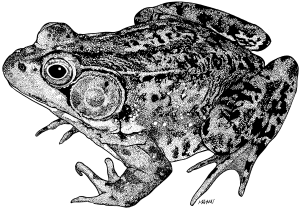 |
|
||||||||
FAO. 2009. Rana catesbeiana. In Cultured aquatic species fact sheets. Text by Flores Nava, A. Edited and compiled by Valerio Crespi and Michael New. CD-ROM (multilingual).
|
|||||||||
IDENTITY
Biological features
One of the largest frogs of the genus Rana, which can reach up to 20 cm in snout-to-vent length (SV-L), and up to 800 g in weight.
Body robust, with wide, flat head. Skin smooth and plain (no wrinkles, warts or spikes), dominantly pale green with brown spots on the dorsal and lateral parts of the body, including limbs and head. Abdominal side white. In adult males, upper abdomen temporarily turns yellowish as sexual maturity approaches. Anterior limbs short. Posterior legs robust and long (representing up to 50 percent of total body length, and up to 40 percent of total body weight). Both anterior and posterior limbs possess inter-digital swimming webs. Sexual dimorphism is present in this species, although it is only conspicuous when pre-adult stage is reached.
Body robust, with wide, flat head. Skin smooth and plain (no wrinkles, warts or spikes), dominantly pale green with brown spots on the dorsal and lateral parts of the body, including limbs and head. Abdominal side white. In adult males, upper abdomen temporarily turns yellowish as sexual maturity approaches. Anterior limbs short. Posterior legs robust and long (representing up to 50 percent of total body length, and up to 40 percent of total body weight). Both anterior and posterior limbs possess inter-digital swimming webs. Sexual dimorphism is present in this species, although it is only conspicuous when pre-adult stage is reached.
Images gallery
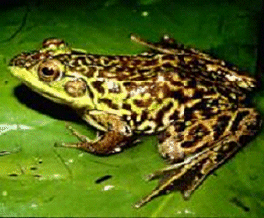
Rana catesbeiana |
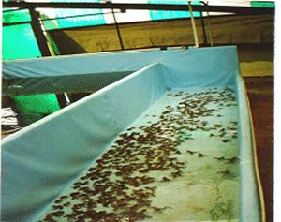
Nursery tank, attached to a tadpole rearing tank (Guatemala)
|
|
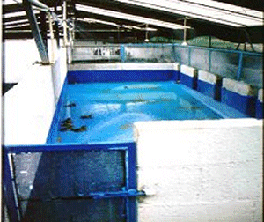
Controlled-environment breeding pen (Yucatan, Mexico) |
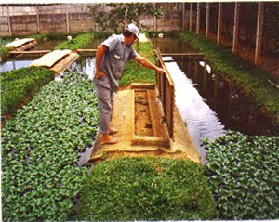
Semi-natural bullfrog breeding pen (Central Brazil) |
PROFILE
Historical background
The American bullfrog is native to North America. Its natural geographical distribution extends from the south-eastern Canadian province of New Brunswick in the north, southwards through eastern United States to Florida, Alabama and the south-eastern part of Texas. It has been introduced to a number of other regions, including Central and South America, the Caribbean islands, and Northeast and South-eastern Asia.
The first documented attempts to cultivate the American bullfrog date back to the late XIX century in the United States. Primitive farms consisted of fenced earthen ponds, where tadpoles were stocked to feed on natural productivity. Young frogs would congregate along the edge of the pond to feed on insect larvae hatched on decomposing meat or other kitchen wastes deliberately placed as spawning substrates. Poor yields soon discouraged such pioneering attempts. By the late 1930s, bullfrogs had been introduced in Brazil, and the first frog farm outside the United States was established. Success was marginal due to the lack of sufficient food, cannibalism and disease problems. Bullfrog farming re-gained popularity in Brazil in the mid 1970s. Small ventures multiplied and academic groups got involved in research until late 1980s, developing a range of culture facility designs and culture techniques for bullfrogs, whose systems are described in the production section of this fact sheet.
Taiwan Province of China imported the first batch of bullfrogs as a potential alternative aquaculture species in the 1950s. A research programme aimed at the cultivation of Rana catesbeiana was then established.
The first attempts to cultivate this species in Mexico began in the early 1960s, when this species was introduced. The first farm was established with the objective of meeting the growing demand for live frogs in the United States. The farm had breeding, tadpole rearing and fattening facilities and eventually became an extensive tadpole-producing facility for stocking natural water bodies that later became frog fishing grounds.
Between 1968 and 1990, two research groups in United States, at the University of Michigan, and at Louisiana State University, carried out research on culture techniques for bullfrogs as laboratory animals, and on its reproductive physiology, pathology and nutrition.
In the early 1990s Thai farmers also began culturing frogs, and R. catesbeiana (along with Rana tigerina, a species native to Southeast Asia) became a popular culture species, technically supported by Chulalongkorn University.
Between 1991 and 2001, the Center for Research and Advanced Studies (Cinvestav) of Mexico, carried out a comprehensive applied research programme for its cultivation, resulting in further advances in reproductive physiology, nutrition, pathology and ecophysiology, which led to the development of an inundated-type culture system that is currently in commercial use in a number of regions of Mexico and Central America.
The first documented attempts to cultivate the American bullfrog date back to the late XIX century in the United States. Primitive farms consisted of fenced earthen ponds, where tadpoles were stocked to feed on natural productivity. Young frogs would congregate along the edge of the pond to feed on insect larvae hatched on decomposing meat or other kitchen wastes deliberately placed as spawning substrates. Poor yields soon discouraged such pioneering attempts. By the late 1930s, bullfrogs had been introduced in Brazil, and the first frog farm outside the United States was established. Success was marginal due to the lack of sufficient food, cannibalism and disease problems. Bullfrog farming re-gained popularity in Brazil in the mid 1970s. Small ventures multiplied and academic groups got involved in research until late 1980s, developing a range of culture facility designs and culture techniques for bullfrogs, whose systems are described in the production section of this fact sheet.
Taiwan Province of China imported the first batch of bullfrogs as a potential alternative aquaculture species in the 1950s. A research programme aimed at the cultivation of Rana catesbeiana was then established.
The first attempts to cultivate this species in Mexico began in the early 1960s, when this species was introduced. The first farm was established with the objective of meeting the growing demand for live frogs in the United States. The farm had breeding, tadpole rearing and fattening facilities and eventually became an extensive tadpole-producing facility for stocking natural water bodies that later became frog fishing grounds.
Between 1968 and 1990, two research groups in United States, at the University of Michigan, and at Louisiana State University, carried out research on culture techniques for bullfrogs as laboratory animals, and on its reproductive physiology, pathology and nutrition.
In the early 1990s Thai farmers also began culturing frogs, and R. catesbeiana (along with Rana tigerina, a species native to Southeast Asia) became a popular culture species, technically supported by Chulalongkorn University.
Between 1991 and 2001, the Center for Research and Advanced Studies (Cinvestav) of Mexico, carried out a comprehensive applied research programme for its cultivation, resulting in further advances in reproductive physiology, nutrition, pathology and ecophysiology, which led to the development of an inundated-type culture system that is currently in commercial use in a number of regions of Mexico and Central America.
Main producer countries
Although production of this species is reported to FAO by only two countries, commercial farms also exists in Mexico, Guatemala, Salvador, Panama, Ecuador, Argentina, Thailand, Indonesia, the Lao People's Democratic Republic, Viet Nam and Malaysia, while experimental farms exist in the USA, Cuba and Puerto Rico. It is likely that production from the other commercial farms is reported to FAO under the more general statistical category 'frogs (Rana spp.)'.
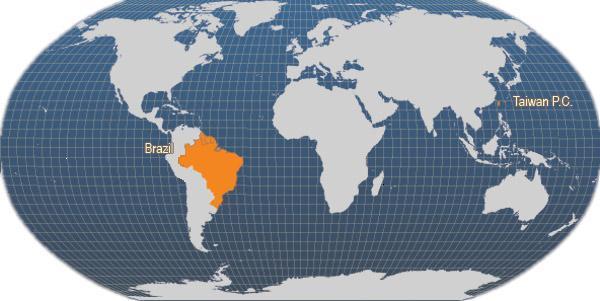
Main producer countries of Rana catesbeiana
(FAO Fishery statistics, 2006)
|
Habitat and biology
Bullfrogs readily adapt to and occur throughout a wide range of climatic conditions. They are found in temperate regions, where they hibernate to withstand below-freezing ambient temperatures, and also in tropical regions, where temperatures reach 40 °C during summer months.
The reproductive physiology of bullfrogs is highly influenced by temperature, photoperiod, ambient humidity, and barometric pressure. Consequently, the closer a population is to the Equator, the wider the length of its reproductive period. While year-round spawning is common in bullfrog stocks from Panama and Ecuador, wild stocks in Mississippi (USA) have a three-month reproductive season.
Metamorphosis of tadpoles is dependent upon two types of ecological factors:
In general, bullfrogs from the northern hemisphere (i.e. Asia, North and Central America) reproduce from March through August, while populations from countries south of the Equator (i.e. Brazil, Uruguay and Argentina) reproduce from September through February. The fecundity of bullfrogs is a function of age, rather than body mass. In farmed females, between 1 300 and 33 000 laid eggs have been recorded from first-spawning and 3-year females, respectively.
Embryonic development and timing to metamorphosis are highly temperature-dependent. In tropical regions (>26 °C) hatching occurs within 48 hours. The concentration of dissolved oxygen is of particular importance at this stage, therefore egg masses have to be kept near the surface. DO levels should be >3 mg/litre. Newly-hatched larvae are approximately 10 mm in length and attach to smooth surfaces by means of an oral sucker. They have a yolk sac that is consumed in approximately 72 hours at ≥26 °C. Immediately after the yolk sac is exhausted, larvae become free-swimming, filter feeding tadpoles.
Ontogenic transition of feeding habits include filter-feeding of phytoplankton, grazing on benthic algae, detritophagy and a gradual shift towards animal protein ingestion, before reaching the metamorphic climax when nourishment becomes briefly autogenic. After tail resorption, froglets become carnivores.
Farmed frog stocks can achieve a survivorship of more than 50 percent. Genetic variability expresses through a significant asynchrony in growth and timing to sexual maturity within every cohort, therefore, under tropical conditions, fitter individuals can reach market size (>180 g), in 3 months after metamorphosis, and sexual maturity in as early as 7 months after hatching, while weakest may take over one year.
The reproductive physiology of bullfrogs is highly influenced by temperature, photoperiod, ambient humidity, and barometric pressure. Consequently, the closer a population is to the Equator, the wider the length of its reproductive period. While year-round spawning is common in bullfrog stocks from Panama and Ecuador, wild stocks in Mississippi (USA) have a three-month reproductive season.
Metamorphosis of tadpoles is dependent upon two types of ecological factors:
- Adequate environmental conditions (temperature, water quality, availability of food).
- Competitive interactions (intra- and inter-specific competition and presence of predators).
In general, bullfrogs from the northern hemisphere (i.e. Asia, North and Central America) reproduce from March through August, while populations from countries south of the Equator (i.e. Brazil, Uruguay and Argentina) reproduce from September through February. The fecundity of bullfrogs is a function of age, rather than body mass. In farmed females, between 1 300 and 33 000 laid eggs have been recorded from first-spawning and 3-year females, respectively.
Embryonic development and timing to metamorphosis are highly temperature-dependent. In tropical regions (>26 °C) hatching occurs within 48 hours. The concentration of dissolved oxygen is of particular importance at this stage, therefore egg masses have to be kept near the surface. DO levels should be >3 mg/litre. Newly-hatched larvae are approximately 10 mm in length and attach to smooth surfaces by means of an oral sucker. They have a yolk sac that is consumed in approximately 72 hours at ≥26 °C. Immediately after the yolk sac is exhausted, larvae become free-swimming, filter feeding tadpoles.
Ontogenic transition of feeding habits include filter-feeding of phytoplankton, grazing on benthic algae, detritophagy and a gradual shift towards animal protein ingestion, before reaching the metamorphic climax when nourishment becomes briefly autogenic. After tail resorption, froglets become carnivores.
Farmed frog stocks can achieve a survivorship of more than 50 percent. Genetic variability expresses through a significant asynchrony in growth and timing to sexual maturity within every cohort, therefore, under tropical conditions, fitter individuals can reach market size (>180 g), in 3 months after metamorphosis, and sexual maturity in as early as 7 months after hatching, while weakest may take over one year.
PRODUCTION
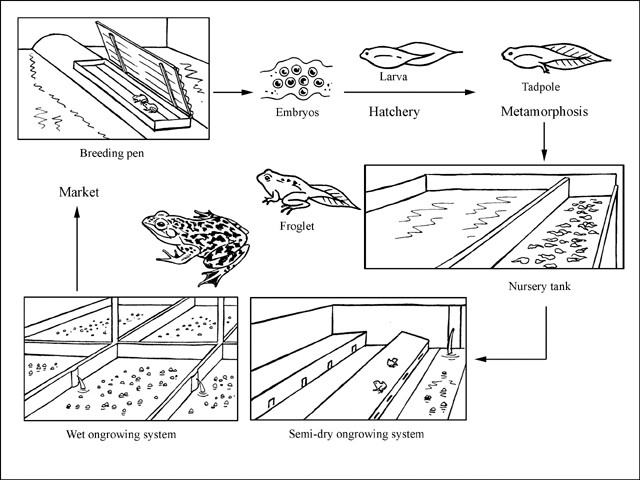
Various strategies are employed by bullfrog farmers to obtain seed. These include collection of egg masses or tadpoles from the wild, as well as semi-natural breeding in captivity (semi-controlled reproduction), and more recently, environmental and hormonal manipulation for controlled reproduction.
Collection from the wild
Many small farmers of Latin America, in areas where wild bullfrog populations occur, collect tadpoles during the breeding season. Smaller tadpoles (<50 mm) are transported in oxygen-saturated water in plastic bags at 1 500-2 000/litre. Metamorphosing tadpoles are also collected. These are placed on soaked cotton sheets, and transported in perforated cardboard boxes at 250/m2 of box bottom area.
Semi-natural reproduction
This consists of stocking adult males and females in breeding pens where practically no management other than feeding is practiced. Breeding pens are of two types. Asian farmers employ 10-20 m2 square concrete tanks, with 1 m walls and an 8-12 cm permanent water layer. Water flows through the tank continuously. Breeders are stocked at 1-5/m2 , and a sex ratio of 1 male: 1-3 females. Feeding consists of 40 percent protein floating pellets, provided once a day at 2.5-3 percent bodyweight/day.
Latin American bullfrog farms generally employ a semi-dry type of breeding pen. This consists of an area of variable dimensions (they range from 10 to 1 600 m2 ), constructed of cinder block or agricultural shade cloth. Some pens also have a top mesh to prevent avian predation. Between 75 and 90 percent of the total floor surface area of the pen is covered by grass, while the rest has shallow (<10 cm) concrete-lined puddles. These latter are used as spawning sites and can be small (1 m2 ), for one breeding couple at a time, or large enough for collective breeding (20-60 m2 ). Feeding points and shelters are also present. Feeding consists of a 40 percent protein pellet, fed once daily at 2.5-3 percent bw/day, together with 2-3 percent bw/day fly (Musca domestica) larvae.
Controlled reproduction
Controlled reproduction involves the manipulation of ambient and water temperature, ambient humidity and photoperiod in indoor breeding facilities. Such strategies are usually sufficient to stimulate reproduction throughout the year, especially in thermally stable latitudes. However, hormonal stimulation is occasionally employed. Intensive bullfrog farms in Mexico and Guatemala employ indoor breeding facilities, which retain heat through a greenhouse effect. Buildings are divided into three sections:
Hatchery
Most farms use their tadpole rearing tanks to incubate fertilized spawns. However, some others have specific incubation facilities. These involve concrete buildings where eggs are placed in small (1 m2) plastic or fibreglass containers. Fertilized eggs are kept in a shallow (5-8 cm), static, chlorine-free, clean water layer in a shaded, ventilated (25-26 °C) site. No aeration is employed. Hatching takes place within 48 hours at 26 °C.
Tadpole rearing
Once tadpoles reach the first-feeding stage, they are transferred to the tadpole rearing tanks. Phytoplankton inoculation is carried out for the first two weeks, and then supplementary feeding is provided 2-4 times a day. The recommended stocking density is 50/m2.
Water quality is maintained by running freshwater continuously through the tank (1-1.5 times/day), or through aeration. Culling is a routine procedure to lower intra-specific competition. Timing to metamorphosis varies greatly among individuals. Precocious tadpoles become froglets in 45 days, while most of the population achieves this in 90-120 days, and a small portion of the cohort (7-12 percent) will metamorphose after one year or more, even in tropical conditions.
Nursery
Nursery tanks are only used in the wet, Mexican system. These are 5.0 x 2.5 x 0.40 m and attached to the tadpole rearing tanks (see photograph in the images gallery). Here froglets are trained to feed on inert, floating pellets. Through routine culling, weaker, slow-growing individuals are removed. Froglets are stocked at between 50 and 75/m2. A 2 cm water layer is maintained permanently. Young frogs are fed ad libitum at least 6 times a day with 1/16', 40 percent crude protein, floating crumbles, until they reach 30-45 g, which normally takes between 30 and 45 days at 26 °C.
Ongrowing systems can be classified into two major types: dry, and semi-dry and wet (inundated) systems.
Dry systems
These include the Brazilian designs mentioned in the following table.
Semi-dry and wet systems
This category comprises a number of systems employed in Southeast Asia, as well as some Latin American versions employed in Mexico, Guatemala, Argentina and Uruguay. The following table summarizes the main operational and productive characteristics.
Specific frog feed is used in some Asian countries, while Latin American farmers employ chiefly tilapia or trout feeds.
Once frogs reach market size, they are prepared for harvest. Frogs are starved for 24 hrs before harvest. In semi-dry systems, ongrowing rooms are drained and frogs are collected manually. Harvesting is carried out in much the same way in wet systems although, in some farms, iced water is pumped into the tanks to hypothermally anaesthetize the frogs to allow for better handling.
Processing of frogs is carried out in certified processing facilities. Frogs are hypothermally anaesthetized (12´at 4 °C) and then slaughtered. Processing includes bleeding, skinning and cutting off the lower limbs, which are then thoroughly cleansed using chlorinated water. Then the legs are individually bagged, frozen and packed by size in master boxes for transport. Frog legs are kept frozen at -15±2 °C which gives them a shelf life of up to 6 months.
Frogs for the live or scientific markets are manually rinsed and packed in 25-lb waxed perforated cardboard boxes. Live frogs are transported under cool and dry conditions by plane. Survival is usually up to 99 percent when the journey does not exceed 72 hrs.
The annual operating costs for a 36 tonnes/yr bullfrog farm (in Mexico) have been reported to total USD 67 560 (41 percent feed; 31 percent labour). Fixed investment costs were USD 130 000 (land USD 20 000; infrastructure USD 90 000; equipment USD 16 000; and initial broodstock USD 4 000).
Production cycle

Production cycle of Rana catesbeiana
Production systems
Seed supply
Various strategies are employed by bullfrog farmers to obtain seed. These include collection of egg masses or tadpoles from the wild, as well as semi-natural breeding in captivity (semi-controlled reproduction), and more recently, environmental and hormonal manipulation for controlled reproduction.
Collection from the wild
Many small farmers of Latin America, in areas where wild bullfrog populations occur, collect tadpoles during the breeding season. Smaller tadpoles (<50 mm) are transported in oxygen-saturated water in plastic bags at 1 500-2 000/litre. Metamorphosing tadpoles are also collected. These are placed on soaked cotton sheets, and transported in perforated cardboard boxes at 250/m2 of box bottom area.
Semi-natural reproduction
This consists of stocking adult males and females in breeding pens where practically no management other than feeding is practiced. Breeding pens are of two types. Asian farmers employ 10-20 m2 square concrete tanks, with 1 m walls and an 8-12 cm permanent water layer. Water flows through the tank continuously. Breeders are stocked at 1-5/m2 , and a sex ratio of 1 male: 1-3 females. Feeding consists of 40 percent protein floating pellets, provided once a day at 2.5-3 percent bodyweight/day.
Latin American bullfrog farms generally employ a semi-dry type of breeding pen. This consists of an area of variable dimensions (they range from 10 to 1 600 m2 ), constructed of cinder block or agricultural shade cloth. Some pens also have a top mesh to prevent avian predation. Between 75 and 90 percent of the total floor surface area of the pen is covered by grass, while the rest has shallow (<10 cm) concrete-lined puddles. These latter are used as spawning sites and can be small (1 m2 ), for one breeding couple at a time, or large enough for collective breeding (20-60 m2 ). Feeding points and shelters are also present. Feeding consists of a 40 percent protein pellet, fed once daily at 2.5-3 percent bw/day, together with 2-3 percent bw/day fly (Musca domestica) larvae.
Controlled reproduction
Controlled reproduction involves the manipulation of ambient and water temperature, ambient humidity and photoperiod in indoor breeding facilities. Such strategies are usually sufficient to stimulate reproduction throughout the year, especially in thermally stable latitudes. However, hormonal stimulation is occasionally employed. Intensive bullfrog farms in Mexico and Guatemala employ indoor breeding facilities, which retain heat through a greenhouse effect. Buildings are divided into three sections:
- A series of 3-5, 25 m2, sex-segregated broodstock-holding tanks.
- A collective meeting area for males and females.
- A series of small (1 m2) spawning puddles.
Hatchery
Most farms use their tadpole rearing tanks to incubate fertilized spawns. However, some others have specific incubation facilities. These involve concrete buildings where eggs are placed in small (1 m2) plastic or fibreglass containers. Fertilized eggs are kept in a shallow (5-8 cm), static, chlorine-free, clean water layer in a shaded, ventilated (25-26 °C) site. No aeration is employed. Hatching takes place within 48 hours at 26 °C.
Nursery
Tadpole rearing
Once tadpoles reach the first-feeding stage, they are transferred to the tadpole rearing tanks. Phytoplankton inoculation is carried out for the first two weeks, and then supplementary feeding is provided 2-4 times a day. The recommended stocking density is 50/m2.
Water quality is maintained by running freshwater continuously through the tank (1-1.5 times/day), or through aeration. Culling is a routine procedure to lower intra-specific competition. Timing to metamorphosis varies greatly among individuals. Precocious tadpoles become froglets in 45 days, while most of the population achieves this in 90-120 days, and a small portion of the cohort (7-12 percent) will metamorphose after one year or more, even in tropical conditions.
Nursery
Nursery tanks are only used in the wet, Mexican system. These are 5.0 x 2.5 x 0.40 m and attached to the tadpole rearing tanks (see photograph in the images gallery). Here froglets are trained to feed on inert, floating pellets. Through routine culling, weaker, slow-growing individuals are removed. Froglets are stocked at between 50 and 75/m2. A 2 cm water layer is maintained permanently. Young frogs are fed ad libitum at least 6 times a day with 1/16', 40 percent crude protein, floating crumbles, until they reach 30-45 g, which normally takes between 30 and 45 days at 26 °C.
Ongrowing techniques
Ongrowing systems can be classified into two major types: dry, and semi-dry and wet (inundated) systems.
Dry systems
These include the Brazilian designs mentioned in the following table.
| System | Main physical characteristics | Countries |
| Aquaterrarium | Earthen or concrete, shallow, narrow, long open canals with sloped, grass-covered banks and terraces | Brazil, Mexico |
| Tank-Island | Square 20-30 m2 walled, roofless, grass-covered floor, with a central concrete platform (10% surface area), surrounded by a shallow (<0.10 m) canal | Brazil, Taiwan Province of China |
| Confinement Rooms | Square, 12 m2, concrete floored, walled rooms. Floor is a ramp with its lower part under a water layer and roofed | Brazil |
| Amphifarm | Concrete, closed buildings containing 8-12, 20-25 m2, concrete floored on-growing rooms. Floor has two narrow canals, pre-fabricated shelters and feeding troughs | Brazil, Ecuador |
| Greenhouses | Wooden or concrete 4-8 m2 tanks with partially flooded floor. Tanks are placed in wooden or metallic-framed, plastic or tarpaulin-roofed building | Brazil, Argentina, Uruguay, México, Guatemala |
| Ranabox | Vertical array of wooden or fibreglass, heated boxes with water and feed trays | Brazil, Argentina |
Semi-dry and wet systems
This category comprises a number of systems employed in Southeast Asia, as well as some Latin American versions employed in Mexico, Guatemala, Argentina and Uruguay. The following table summarizes the main operational and productive characteristics.
| Wet surface area | 30-50% of total bottom area of fattening tank | 100% of total bottom area of fattening tank |
| Water dynamics | Static | Flow-through |
| Nursery stage | No | Yes |
| Average yield | 12-16 kg/m2 | 14-22 kg/m2 |
| Type of feed | Supplementary + live (fly larvae) | 100% supplementary feed |
| Functional versatility | Limited | High |
Feed supply
Specific frog feed is used in some Asian countries, while Latin American farmers employ chiefly tilapia or trout feeds.
Harvesting techniques
Once frogs reach market size, they are prepared for harvest. Frogs are starved for 24 hrs before harvest. In semi-dry systems, ongrowing rooms are drained and frogs are collected manually. Harvesting is carried out in much the same way in wet systems although, in some farms, iced water is pumped into the tanks to hypothermally anaesthetize the frogs to allow for better handling.
Handling and processing
Processing of frogs is carried out in certified processing facilities. Frogs are hypothermally anaesthetized (12´at 4 °C) and then slaughtered. Processing includes bleeding, skinning and cutting off the lower limbs, which are then thoroughly cleansed using chlorinated water. Then the legs are individually bagged, frozen and packed by size in master boxes for transport. Frog legs are kept frozen at -15±2 °C which gives them a shelf life of up to 6 months.
Frogs for the live or scientific markets are manually rinsed and packed in 25-lb waxed perforated cardboard boxes. Live frogs are transported under cool and dry conditions by plane. Survival is usually up to 99 percent when the journey does not exceed 72 hrs.
Production costs
The annual operating costs for a 36 tonnes/yr bullfrog farm (in Mexico) have been reported to total USD 67 560 (41 percent feed; 31 percent labour). Fixed investment costs were USD 130 000 (land USD 20 000; infrastructure USD 90 000; equipment USD 16 000; and initial broodstock USD 4 000).
Diseases and control measures
The major disease problems affecting American bullfrogs are included in the table below.
In some cases antibiotics and other pharmaceuticals have been used in treatment but their inclusion in this table does not imply an FAO recommendation.
Suppliers of pathology expertise
Assistance can be obtained from the following sources:
In some cases antibiotics and other pharmaceuticals have been used in treatment but their inclusion in this table does not imply an FAO recommendation.
| DISEASE | AGENT | TYPE | SYNDROME | MEASURES |
| 'Red leg' disease. | Occurrence of several bacteria, either synergistically or mono-specifically. The most common genera are Aeromonas, Pseudomonas, Klebsiella, Edwardsiella, Myma, Streptococcus | Bacteria | Red legs; red anus | Antibiotics; biosecurity; movement of non-infected organisms only |
| General oedema | Most common causative genera are Streptococcus and Staphylococcus | Bacteria | General swelling | Antibiotics; biosecurity; movement of non-infected organisms only |
| 'Swirling' disease | Most commonly found genera in diseased organisms are Aeromonas, Streptococcus and Staphylococcus | Bacteria | – | Antibiotics; biosecurity; movement of non-infected organisms only |
| Tuberculosis | Mycobacterium spp. | Bacteria | Tuberculosis; surface ulcers may appear | Antibiotics; biosecurity; movement of non-infected organisms only |
| Mycosis | Achlya spp., Saprolegnia spp. | Fungus | Ulcers, sometime with visible mycelia; skin reddening | Fungicides; biosecurity |
| Environmental | Various (congenital, nutritional, environmental) | – | – | Good management practices |
Suppliers of pathology expertise
Assistance can be obtained from the following sources:
- Dr. Marcio Hipolito, Instituto Biológico de Sao Paulo, Brazil.
- Dr. Putsatee Paryanonth, Chulalongkorn University, Bangkok, Thailand.
- Dr. Victor Vidal, Center for Research and Advanced Studies (CINVESTAV), Merida, Mexico.
- Dr. Daniel Carnevia Instituto Nacional de Pesca, Montevideo, Uruguay.
STATISTICS
Production statistics
|
Global aquaculture production of Rana catesbeiana
(FAO Fishery statistics)  |
|
Market and trade
In 1980, it was estimated that 3 percent of the global market of frogs (all species) was supplied by aquaculture, while the current (2002) estimated contribution is 15 percent, taking into account the calculated growth rate of the industry.
Market statistics for frogs are scarce and unreliable. Some documented demand statistics place the USA as the highest consumer of frogs (all species), followed by France, Canada, Belgium, Italy and Spain.
There are three major market niches for bullfrogs, namely:
The demand for live frogs for food has increased especially amongst Asian groups living in Canada and the USA. Wholesaler prices range between USD 2.25 and USD 3.75/kg of whole frog, depending on weight. The main producers (capture and aquaculture) are Taiwan Province of China, Brazil and Mexico.
Live bullfrogs for educational or scientific purposes are sold in the USA to processing companies. Three size-categories are marketed: 4-5', 5-6', and 6-7' (S-VL); prices range from USD 1.30-3.25 each.
Market statistics for frogs are scarce and unreliable. Some documented demand statistics place the USA as the highest consumer of frogs (all species), followed by France, Canada, Belgium, Italy and Spain.
There are three major market niches for bullfrogs, namely:
- Frog legs.
- Live frogs.
- Educational and scientific requirements.
The demand for live frogs for food has increased especially amongst Asian groups living in Canada and the USA. Wholesaler prices range between USD 2.25 and USD 3.75/kg of whole frog, depending on weight. The main producers (capture and aquaculture) are Taiwan Province of China, Brazil and Mexico.
Live bullfrogs for educational or scientific purposes are sold in the USA to processing companies. Three size-categories are marketed: 4-5', 5-6', and 6-7' (S-VL); prices range from USD 1.30-3.25 each.
STATUS AND TRENDS
Continued research efforts focusing on nutrition, pathology and reproduction are expected to result in important improvements that will boost production in the future. However, there is still much to be done on genetics. Marketwise, prices will tend to gradually increase, as trading of wild-caught frogs becomes restricted, thus being replaced by farmed animals; nonetheless, important efforts should focus on marketing and advertising, since frog meat and its attributes are far from being widely known.
MAIN ISSUES
As in any other type of aquaculture, bullfrog farming can cause problems if not managed properly. The following table summarizes a series of externalities likely to be generated by frog farming, as well as the risks involved and some suggestions for their prevention or mitigation.
| Externality | Risks | Mitigation strategies |
| Organic discharges | Eutrophication and ecological alteration of surrounding waters; organic pollution of water used for human consumption | On farm wastewater treatment; wastewater re-use in agriculture; use of low-polluting feeds |
| Release of antibiotics | Stimulation of natural bacterial resistance | Discourage use of antibiotics; replace drugs with efficient management and prophylaxis |
| Introduction of exotic species | Introduction of non-native pathogens; out-competition of local species; unwanted hybridization | Implement preliminary ecological impact studies; adopt strict bio-security measures to prevent escapes; quarantine introduced organisms |
| Resources use conflicts | Water or land that is or can be used in a more efficient way to generate more social benefits | Make a comparative cost/benefit analysis with other economic or social activities already in place or potential |
| Collection of eggs and tadpoles from the wild | Diminishes recruitment of commercially important frog fisheries | Carry out population dynamics studies; use aquaculture to re-stock natural fishing grounds |
Responsible aquaculture practices
All countries request sanitary certification when buying frog legs but no CITES paperwork is required.
It is important to develop specific regulatory frameworks for bullfrog farming, as it is becoming an important aquaculture activity in many regions. It should also follow the general principles adopted by the Code of Conduct for Responsible Fisheries, Article 9.
It is important to develop specific regulatory frameworks for bullfrog farming, as it is becoming an important aquaculture activity in many regions. It should also follow the general principles adopted by the Code of Conduct for Responsible Fisheries, Article 9.
REFERENCES
Bibliography
|
Aguiar, H. 1992. O sistema vertical ranabox. In Anais do VII Encontro Nacional de Ranicultores. Rio de Janeiro, Brazil, avril 6-9, 1992, pp. 65-70. Associação dos Ranicultores de Rio de Janeiro. Benitez, M.M. & Flores-Nava, A. 1997. Growth and metamorphosis of Rana catesbeiana (Shaw) tadpoles fed live and supplementary feed, using tilapia Oreochromis niloticus (L.) as a biofertilizer. Aquaculture Research, 28:481-488. Carmona, C., Olvera, M.A., Flores-Nava y V. & Ontiveros, A. 1997. La nutrición de la rana y su importancia en ranicultura. In Mem. II Technofrog ´97. International Meeting on Frog Research and Technology. Santos, Brazil, July 19-23, 1997, pp. 75-81. Academia Brasileira de Estudos Tecnicos em Ranicultura. Chamberlain, F.M. 1897. Notes on the edible frogs of the United States and their artificial propagation. US Bureau of Fisheries. Fisheries Document for 1897. pp. 249-261. Washington, DC, USA. Chen, T.P. 1976. Aquaculture Practices in Taiwan. Page Bros, Norwich, UK. 162 pp. Culley, D.D. 1976. Culture and management of the laboratory frog. Laboratory Animal, 5:30-36. Culley, D.D. 1991. Bullfrog culture. In C.E. Nash (ed.), Production of Aquatic Animals. World Animal Science C4, pp. 185-205. Elsevier, Amsterdam, Netherlands. Culley, D.D., Horseman, N.D., Amborski, R.L. & Meyers, S.P. 1978. Current status of amphibian culture with emphasis on nutrition, diseases and reproduction of the bullfrog Rana catesbeiana. Proceedings of the World Mariculture Society, 9:653-670. Donizete, T.R. 1997. Avaliaçao do Mercado mundial de carne de rana. In Mem. II Technofrog ´97. International Meeting on Frog Research and Technology. Santos, Brazil, July 19-23, 1997, pp. 3-11. Academia Brasileira de Estudos Tecnicos em Ranicultura. Easley, K.A., Culley, D.D., Horseman, N.D. & Penkala, J.E. 1979. Environmental influences in hormonally induced spermiation of the bullfrog Rana catesbeiana. Journal of Experimental Zoology, 207:407-416. Flores-Nava, A. 1992. Specific phytoplankton consumption rates and preferences by tadpoles of the bullfrog Rana catesbeiana fed a polyculture of microalgae. In Abstracts of World Aquaculture ´92, Orlando, Florida, May 21-25, 1992, pp. 139-140. World Aquaculture Society, Baton Rouge, Louisiana, USA. Flores-Nava, A. 1993. Avances en la investigación y desarrollo de la tecnología del cultivo de rana en el sureste de México. In Mem. I Simposio Internacional de Investigación Acuícola en Centroamérica. San José, Costa Rica, octubre 5-8, 1993, pp. 99-106. Universidad Nacional de Costa Rica. Imprenta Universitaria, San Jose, Costa Rica. Flores-Nava, A. 1994. An overview of frog farming in México. In K.P.P. Nambiar & T. Singh (eds.). Proceedings of the INFOFISH-AQUATECH ´94 International Conference on Aquaculture, Colombo, Sri Lanka, August 29-31, 1994, pp. 131-137. INFOFISH, Kuala Lumpur, Malaysia. Flores-Nava, A. 1999. Cultivo Intensivo de Rana Toro Rana catesbeiana. Manual. Técnicas de Acuicultura. Programa Regional de Apoyo al Desarrollo de la Pesca en el Istmo Centroamericano (PRADEPESCA-Unión Europea). Panama. 42 pp. Flores-Nava, A. & Vera, P. 1999. Growth, metamorphosis and feeding behavior of Rana catesbeiana Shaw, 1802 tadpoles at different rearing densities. Aquaculture Research, 30:1-7. Flores-Nava, A. 2000. Frog farming: a comparison between the wet and the semi-dry on-growing systems. Global Aquaculture Advocate, 1(1):52-54. Flores-Nava, A. 2001a. Aspectos generales de la biología de Rana catesbeiana de importancia para su cultivo. In T. Jaramillo, Olivera, J. & Velázquez, J. (eds.), Reproducción y Manejo de Fauna Silvestre, pp. 195-210. Universidad Autónoma Metropolitana, México, Distrito Federal, Mexico. Flores-Nava, A. 2001b. Generalidades del cultivo de rana toro Rana catesbeiana, Shaw, 1802. In T. Jaramillo, Olivera, J. & Velázquez, J. (eds.), Reproducción y Manejo de Fauna Silvestre, pp. 211-233. Universidad Autónoma Metropolitana, México, Distrito Federal, Mexico. Flores-Nava, A. 2002. Estudio de factibilidad para el establecimiento de una granja de rana para el mercado exterior, en Panama. Documento de Circulación Restringida. Convenio HO/AFN 0125-2002. Grupo HO-Panama, Panamá. 33 pp. Fontanello, D., Arruda-Soares, H., Mandelli, J., Penteado, L.A. & Justo, C.L. 1984. In Manejo Alimentar de Ras. Mem. IV Encontro Nacional de Ranicultores. Goiania, Brazil, 5-9 novembro, 1984, pp. 91-107. Mim. Associação Goiania dos Criadores de Ras. Glorioso, J.C., Amborski, R.L., Amborski, G.F. & Culley, D.D. 1974. Microbiological studies on septicemic bullfrogs, Rana catesbeiana. American Journal of Veterinary Research, 35:1241-1245. Gosner, K.L. 1960. A simplified table for staging anuran embryos and larvae with notes on identification. Herpetologica Chicago, 16:183-190. Horseman, N.D., Smith, C.A. & Culley, D.D. 1978. Effects of age and photoperiod on ovary size and condition in the bullfrog (Rana catesbeiana Shaw) (Amphibia, Anura, Ranidae). Journal of Herpetology, 12(3):287-290. Lindenbaum, I. 1997. Estadísticas de comercio exterior: Mercado de ancas de rana en USA y Francia. In Proceedings of the II Technofrog ´97. International Meeting on Frog Research and Technology. Santos, Brazil, July 19-23, 1997, pp. 26-38. Academia Brasileira de Estudos Tecnicos en Ranicultura. Lopes-Lima, S. & Agostinho, C.A. 1988. A criaçao de ras. Editorial Globo (Coleçao do agricultor-pequenos animais), Rio de Janeiro, Brazil. 187 pp. Lopes-Lima, S. & Agostinho, C.A. 1992. A tecnología de criaçao de ras. Universidade Federal de Viçosa. Imprenta Universitaria, Viçosa, Minas Gerais, Brazil. 168 pp. Mayes, I. 1963. Folleto instructivo para la cría artificial de la rana comestible rana toro Rana catesbeiana. Boletín del Banco Nacional de Crédito Ejidal, Oficina de Piscicultura, Distrito Federal, México. 47 pp. Nace, G.W. 1968. The amphibian facility of the University of Michigan. Bioscience, 18:767-775. Oloriz, M. 1997. La ranicultura en Uruguay: desarrollo y perspectivas. In Proceedings II Technofrog '97. International Meeting on Frog Research and Technology. July 19–23. Santos, Brazil, p. 8. Academia Brasileira de Estudos Tecnicos em Ranicultura. Ontiveros, E.V., Valdez, R.A., Lili, A., Romano, M. & Flores-Nava, A.2002a. Influencia ambiental sobre el sistema endócrino-reproductivo, maduración gonádica y desoves en hembras de Rana catesbeiana, Shaw, 1802. In Memorias de la. XXVII Reunión Anual de la Academia de Investigación en la Reproducción, A.C. Morelia, Mich., México, jul. 1–3, 2002, p. 250. Academia de Investigación en la Reproducción, A.C., Mexico, Distrito Federal. Ontiveros, V., Flores-Nava, A., Orozco, H., Lili, A., Navarro, M.C. & Ambriz, G. 2002b. Estimación del número de espermatozoides en testículos, a partir de la masa corporal en rana toro Rana catesbeiana Shaw, 1802. In Memorias de la VII Reunión Nacional de Herpetología. Guanajuato, México, nov. 25-28, 2002, p. 122. Sociedad. Mexicana de Herpetología. Paryanonth, P. & Daorerk, V. 1994. Frog farming in Thailand. In K.P.P. Nambiar & T. Singh (eds.). Proceedings of the INFOFISH-AQUATECH ´94 International Conference on Aquaculture, Colombo, Sri Lanka, August 29-31, 1994, pp. 126-130. INFOFISH, Kuala Lumpur, Malaysia. Rubin, R. 1979. La rana y su Explotación. Editorial Continental, México, Distrito Federal. 132 pp. Ryan, M.J. 1980. The reproductive behavior of the bullfrog Rana catesbeiana. Copeia, 1:108-114. Santana-Costa.1992. Desenvolvimento do aparelho reprodutor e fatores associados ao ciclo reproductivo da ra-touro no sistema anfigranja. Unpublished MSc Thesis. Universidade Federal de Viçosa, Mina Gerais, Brazil. 98 pp. Vizotto, L.D. 1979. Aspectos técnicos de ranicultura. In Anais de I Encontro Nacional de Ranicultura. Mimiog. Universidade de Sao Paulo, Brazil, jan. 12–15, 1979, pp. 27-67. Universidade de São Paulo, Brasil. |
